Sean K
Moderator
- Joined
- 21 April 2006
- Posts
- 22,566
- Reactions
- 12,086
Hoping uranium can do it a forth time. Might be just a matter of when.
So on short, our western uranium price is fulling reliant on the Russia/west relationship..does Russia process mote for the west or not...from Global Macro Update
Ed D'Agostino:
So can we maybe unpack one of your more well-known trades, sort of how you got into it, what drew you to it, how you approach a trade? And I'm thinking about uranium because you're, at least on X, formerly known as Twitter, you're sort of a legendary guy when it comes to investing in uranium. You got it right. You were in it back in ‘21. How did you get into it, and what was the setup that got your attention?
Harris Kupperman:
So I was really lucky that I played uranium the last cycle. And so, I made a lot of money the last cycle. It was unusually good to me. And so I've always had a sweet spot for uranium. But the problem is that after Fukushima there was just this excess supply, and the world had too much of it, and it pushed the price down. And, as it always happens to the commodities, I do a lot of commodity investing, when there's too much supply, the price goes down, and eventually a bunch of guys go bankrupt. They stop producing and then you have a deficit and the pricing fixes itself. Every commodity has a different cycle, and this one, it took over a decade from Fukushima until we hit bottom. Well, I guess we hit bottom a little earlier, but before you started seeing any life come into it. But in 2021, we were year three of the deficits, and so we started drawing down above-ground inventory.
But a funny thing happened in that countries that had previously said they were shutting the nuclear power plants, they all made these green commitments. And solar doesn't work when it's not sunny, and wind sometimes doesn't work when it's not windy. And they had too much intermittent power and not enough base load, and they realized that if they were going to continue to phase out their coal power plants, they needed to keep the nuclear on. And so we had all these plants that were supposed to be shutting down, nuclear power plants, that instead got postponements where they were allowed to stay on longer. The Japanese and Koreans decided they were going to turn plants back on. The French decided that they were going to go full in on nuclear. And the US, we did some of the same. And so you had this weird situation where the market was supposed to be balanced based on the current amount of
production or maybe a slight deficit, and instead the deficit became very, very large because the demand for uranium went up much more rapidly that the supply could.
And even today, three years later, the supply response has really been slow because it's really hard to build a mine. And there's a bunch of existing mines that are [inaudible 00:14:51], but even those take a while to come online. But the real catalyst was that an entity called Sprott Physical Uranium Trust, it was launched. It's a Canadian entity. We're shareholders for disclosure. And it was issuing shares and buying pounds, and it sequestered now over 60 million pounds of physical uranium. And that helped clear up a lot of the above-ground inventories that now the deficit can impact the price, and it has impacted the price. When I first started buying, the price of uranium was in the low thirties. Today, it's in the mid-eighties. It got as high as 105 or so. So it's been an okay trade for me. I mean, I've had better trades. I've had worse trades. But it's done well, and I think it's going to continue to do well. And I think at the end of this cycle, as usually happens, there'll be an explosion higher in price.
Usually near the end of these sorts of things, there's a panic and the price goes crazy, and that's what you need to incentivize governments around the world to supply the uranium. There's plenty of uranium. It's not like the power's going to go out, but you're going to need to take this nuclear power out of some other thing like an aircraft carrier. And to do that, you need the price to go crazy, and you need the guys who had this spare governmental uranium to say, “Okay, we'll give it to the commercial market and kind of bridge the gap.” And so we're not there yet. And when we start getting there, that's when I sell. That's been good.
My understanding is we're not even close to the price point yet for spot uranium where it is economical to restart a lot of the mothballed mines, at least the ones that are in North America.
Harris Kupperman:
Sort of, not really. The thing is that these mines, they produced a lot of them a decade ago, and so they were... at today's price of, say, 85, they'd be very profitable. But it's been a decade of inflation, and it's hard to say what the right price is. At the same time, permits lapsed, and there's really not a lot of capital to the industry. I mean, there's a huge uranium bubble going on in the juniors, but despite that bubble, and it really is a bubble, there's not a lot of capital available, which is odd, so you're not seeing a lot of these restarts. I think you'll see that eventually in this cycle. That's how the cycle ends, but that's not now. We're kind of in the mid-stride of the cycle.
Ed D'Agostino:
What do you think about the processing side? Because my understanding is we have very little, if any, processing as well, a refinement of uranium. So we were essentially relying on Russia for the refining.
Harris Kupperman:
We are, and it's very stupid. We should be able to... I mean, it's about 15% of our electricity in America. We should be able to do this ourselves. There's a couple steps along the way. You have to take uranium and turn it into UF-6, then you have to enrich it, then you have to fabricate it into fuel rods. We're short on all of this stuff. The Russians do it cheaper, they do it better, and we closed our plants. Much of America, we outsourced all this stuff, which may have made good financial sense for a bunch of public companies, but it doesn't make good national security sense. And now we're fully at the mercy of the Russians. If they stop supplying us with enriched uranium, we're going to have a real big problem here. But even if you want to build an enrichment facility, it takes years. So there's bottlenecks. And that's one of the reasons actually that the price of uranium hasn't gone up more.
No one's out there buying U3O8, raw uranium, because there's a shortage right now in terms of enrichment and also in terms of UF-6 conversion. So you're not going to buy the initial components if you can't actually turn it into a fuel rod. So because of that supply chain, it's all sort of backed up and you haven't really pulled forward some of that demand. So I think as these things get solved, you'll see the demand for physical uranium, the thing that I own, also grow.
There is a type of uranium fuel that is needed for the newer 4th Gen reactors such as the Terra Power reactor that Gates just started by building in Wyoming that mainly is refined by Russia and China, basically it’s enriched to 20% U235 rather than the standard 5%.So on short, our western uranium price is fulling reliant on the Russia/west relationship..does Russia process mote for the west or not...
We could reach the situation where uranium price could itself collapse while in dire shortage in power station ready fuel..
A bit like cattle price ridiculously low, with steaks at Coles extremely dear, during COVID due to abattoir issues...
The abattoir for uranium being the Ukrainian conflict..a not so pushed analogy
Agreed, it would be great for Australia to have these to back up renewables, as a Side note, that nuclear power plant that gates is building is on a site owned by Warren Buffet’s Berkshire Hathaway energy business, it’s taking the place of a coal plant that is scheduled to shut down later this decade.We’re a bit slow in the Great Aus… the Gates style nuclear plants are a no brainer.
When they will exist, not in blueprintsWe’re a bit slow in the Great Aus… the Gates style nuclear plants are a no brainer.
The Terrapower Nuclear plant is literally under construction right now, they broke ground 2 weeks ago, due to start electricity production in 2030. And the plan to break ground on about 4 more before that first is completed.When they will exist, not in blueprints
It’s a fait accompli in the US now.When they will exist, not in blueprints
just add a look, the fait accompli is 2030 LOLIt’s a fait accompli in the US now.
Gates claims cost is about 4 billion to complete. An absolute bargain for a 60 plus year plant life. Maybe 90 years.
The smart country is stuck with Blackout Bowen in charge of our future electricity supply. Yikes.

|
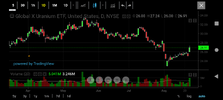
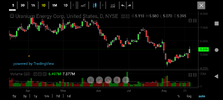
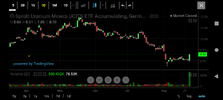
Uranium having a cracker go on US markets right now.
Movement noticed last trading session, however it didn't correspond over to AUS markets today.
Perhaps Monday will be a different story.
More observations required.
On US markets, (first 2 charts)
UEC currently up ~13%
URA currently up ~7%
Last chart Sprotts miners from Germany, market closed. Notice the huge volume.
View attachment 183045View attachment 183046View attachment 183047
Might be of interest @Sean K aka Mr Santorini
Hold onto your horses today.
US markets had some yellowcake flying last night.
UEC up over 11%
This ETF up around 5.5%
View attachment 184123
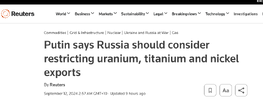
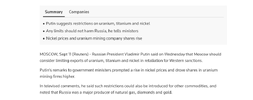
NorilskNickel?
That's a laugh
Hello and welcome to Aussie Stock Forums!
To gain full access you must register. Registration is free and takes only a few seconds to complete.
Already a member? Log in here.